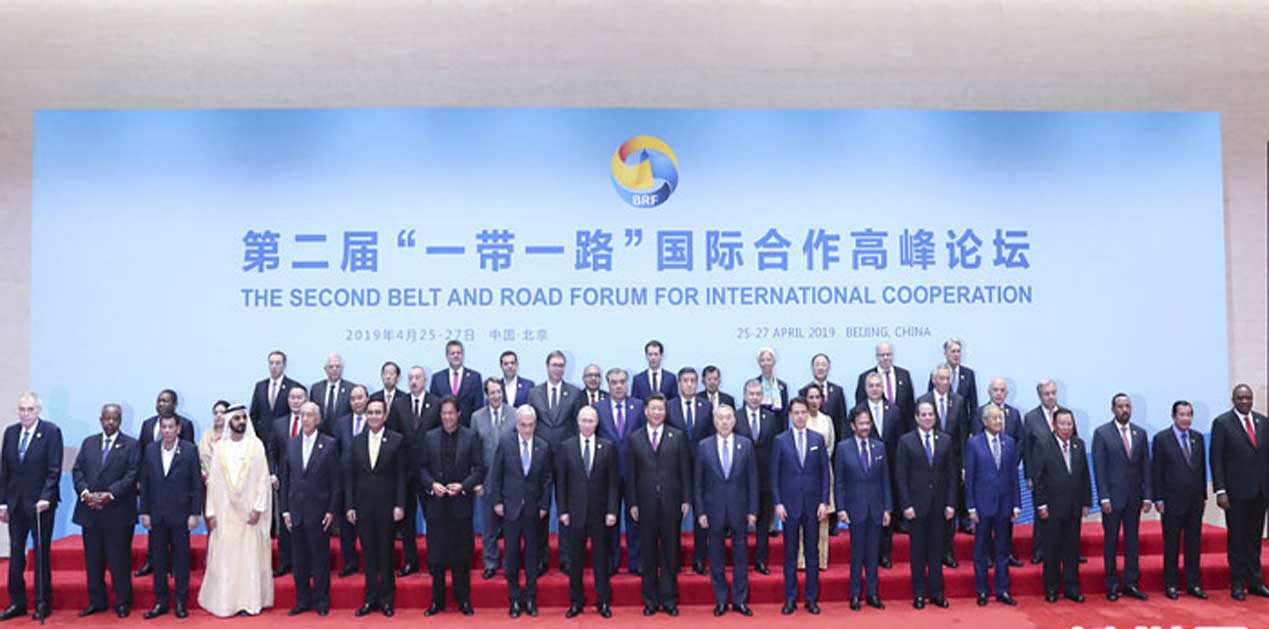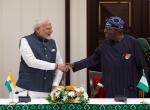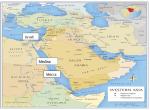The Second Belt and Road Forum for International Cooperation (BRF), titled as ‘Working together to deliver a Brighter Future for Belt and Road Cooperation”, held in Beijing, China on 25-27th April 2019 attracted wide international attention. It was the highest-level platform for international cooperation within the framework of the Belt and Road Initiative (BRI). It was attended by 36 heads of State and government, along with 5,000 other representatives from different countries and 90 members of the international organisation.
Unlike triumphalism that marked the first forum in 2017, this time there was a clear element of defensiveness in China’s position. As a result of its criticism of various aspects of the initiative, Xi Jinping’s speech at the forum emphasised on how to deal with the criticism surrounding the BRI and also came up with some new promises to emphasise ‘quality development’, ‘innovation’, ‘science’, ‘green’, ‘multi-culturalism’ and ‘sustainability’. 1 Some of the tenets of his speech sought to address the criticisms such as absence of ‘joint pursuit’, ‘high-quality infrastructure’ and problems such as ‘debt trap’. 2
There has been a certain level of ambiguity surrounding the concept of BRI. In fact, the definition of the BRI itself is vague. The projects operating prior to BRI have also been brought under the ambit of the BRI. The success or failure of the project so far is also not clear. Along with Chinese unilateralism, there is lack transparency in BRI. Many of the internal projects in different countries are also included in the BRI now.
The Chinese President has, over the past years, announced a series of reforms to send a positive signal to the outside world and respond to western criticism on China’s trade and investments practices. The reforms were essentially to expand market access for foreign investment, intensify efforts to enhance international cooperation in intellectual property, increase import of goods and services, to effectively engage in international macro-economic policy coordination and opening-up related policies. 3 Overall, the inaugural speech was comparatively less enthusiastic than the 2017 summit speech and tried to address the criticism of the BRI.
Over a period of time, the issue of debt trap has become very acute within the BRI. According to a study conducted by the Center of Global Development, out of 23 countries that are under the risk of a debt trap, eight of them are most vulnerable. The most vulnerable countries are: Djibouti, the Maldives, Laos, Montenegro, Mongolia, Tajikistan, Kyrgyzstan, and Pakistan.4 On 25 April 2019, the Ministry of Finance of People’s Republic of China released a ‘Debt Sustainability Framework for Participating Countries of the Belt and Road Initiative’.5 In addition, Xi Jinping announced that he is trying to make the BRI more sustainable both in fiscal and environment terms.6
Attracting Foreign Investments
The most important aspect of foreign investments is foreign investment laws. In order to create a congenial trade environment, on 15 March 2019, China had passed a ‘New Foreign Investment Law’ with the focus on quality. The law is designed to protect the rights and interest of foreign investors and to attract further foreign investment into China.7 During the summit, Xi Jinping confirmed that China will further lower its tariff rates and the country would continuously open up its market and welcome quality products from around the world. China also indicated that it would import more competitive farm produces, finished products and services and will allow foreign investors to operate businesses in more sectors with controlling or full stake. China has promised to step up protecting the legitimate rights and interests of foreign owners of intellectual property rights (IPR), and prohibit the forced transfer of technology. On trade and opening-up, China will increase imports of goods and services on a larger scale, slash its negative list on imports and will negotiate and sign high-standard free trade agreements with more countries.8
The second forum was held against the backdrop of the US-China on-going trade talks. There was no mention of the US-China trade friction in Xi’s speech but it was reflected in it when he stated that “China does not intentionally seek trade surpluses, and the nation is willing to import more foreign agricultural products and services for more balanced trade”, and “not resort to the beggar-thy-neighbour practice of RMB devaluation”.9 In fact, the ‘international cooperation in intellectual property protection’ in his speech does have some resonance of the ongoing IPR issue vis-à-vis Huawei.
In the wake of economic readjustment of the Chinese economy, Xi Jinping emphasised on China’s domestic plans and economic reforms that China will undertake to “strengthen macro policy coordination with other major economies and jointly contribute to robust, sustainable, balanced and inclusive global growth.”10 Addressing the issue of people-to-people Connectivity, Xi Jinping reiterated that China will support people from the innovation sector in Belt and Road countries through training programmes and joint research over the next five years, promote scientific and cultural exchanges, set up joint science labs, build science and technology parks, and promote the transfer of technologies.11 Notably, this year there was no monetary announcements guarantee for the project and no new projects were announced. This is in sharp contrast to the announcement in 2017, where USD 124 billion was allocated for the projects. 12
Conclusion
The summit has indicated that China is amending the BRI to tackle the criticism surrounding it. The Second Forum marks the completion of five years of the BRI. Since the launch of the BRI, there has been a lot of development of the projects. On 27 August 2018, to mark the five years of the BRI, Xi Jinping pointed out that in the last five years the overall broad design has been laid out, and in the future it is necessary to focus on the key points and carefully craft the fine and meticulous “finger paintings”. 13 Prior to the Forum, on 23rd April Xi, Jinping announced the concept of ‘maritime community with a shared destiny.’ The concept has relevance for the BRF as Xi Jinping used the occasion to further rationalise the 21st Century Maritime Silk Road. However, there are no indications that China is going back; the BRI is here to stay with some alteration and should be viewed as China’s quest for world leadership.
Indian stance on the BRI remains unchanged. The government has clearly laid down its position on 13 May 2017 and again on 5 April 2018. It has reiterated that “Our position on OBOR/BRI is clear and there is no change.” Nevertheless, China is continuing to entice India to join it. Even after the summit, the Chinese spokesperson said: “the BRI is an open, inclusive and transparent economic initiative for cooperation. We welcome the participation of all like-minded countries and will work together for win-win outcome consultation and cooperation”.14
References
- With Belt and Road Initiative 2.0, Xi Jinping Pledges to Step up China's Game accessed at https://thewire.in/diplomacy/china-belt-road-initiative-xi-jinping-forum-speech
- Xi Jinping Attends the Opening Ceremony of the Second Belt and Road Forum for International Cooperation (BRF) and Delivers a Keynote Speech. accessed at http://www.beltandroadforum.org/english/n100/2019/0429/c22-1391.html
- Xi Jinping Attends the Opening Ceremony of the Second Belt and Road Forum for International Cooperation (BRF) and Delivers a Keynote Speech.accessed at http://www.beltandroadforum.org/english/n100/2019/0429/c22-1391.html
- Examining the Debt Implications of the Belt and Road Initiative from a policy Perspective accessed at https://www.cgdev.org/sites/default/files/examining-debt-implications-belt-and-road-initiative-policy-perspective.pdf
- Debt Sustainability Framework for Participating Countries of the Belt and Road Initiative accessed at http://m.mof.gov.cn/czxw/201904/P020190425513990982189.pdf
- China grapples with its BRI lending binge accessed at https://www.ft.com/content/c976cde2-6cd0-11e9-80c7-60ee53e6681d
- China to enact policy to ensure success of Foreign Investment Law: Premier accessed at http://www.chinadaily.com.cn/a/201903/15/WS5c8b5ab9a3106c65c34eee0a.html
- Xi Jinping Attends the Opening Ceremony of the Second Belt and Road Forum for International Cooperation (BRF) and Delivers a Keynote Speech accessed at http://www.beltandroadforum.org/english/n100/2019/0429/c22-1391.html
- Six key takeaways from Xi Jinping’s Belt and Road Forum speech to world leaders accessed at https://www.scmp.com/news/china/diplomacy/article/3007758/xi-jinping-delivers-shorter-belt-and-road-forum-keynote
- Xi Jinping Attends the Opening Ceremony of the Second Belt and Road Forum for International Cooperation (BRF) and Delivers a Keynote Speech accessed at http://www.beltandroadforum.org/english/n100/2019/0429/c22-1391.html
- Xi Jinping Attends the Opening Ceremony of the Second Belt and Road Forum for International Cooperation (BRF) and Delivers a Keynote Speech accessed at http://www.beltandroadforum.org/english/n100/2019/0429/c22-1391.html
- Belt and Road development becomes steady, extensive as second forum closes accessed at http://en.people.cn/n3/2019/0507/c90000-9575662.html
- Building a "Belt and Road", Xi Jinping proposed from "big freehand" to "meticulous painting" accessed at http://www.xinhuanet.com/2018-08/28/c_1123341344.htm
- Foreign Ministry Spokesperson Geng Shuang's Regular Press Conference on April 29, 2019 accessed at https://www.fmprc.gov.cn/mfa_eng/xwfw_665399/s2510_665401/2511_665403/t1659619.shtml
Image Source: https://cache.pakistantoday.com.pk/463783_6828457_second-BRI_updates.jpg *







.jpg)


Post new comment